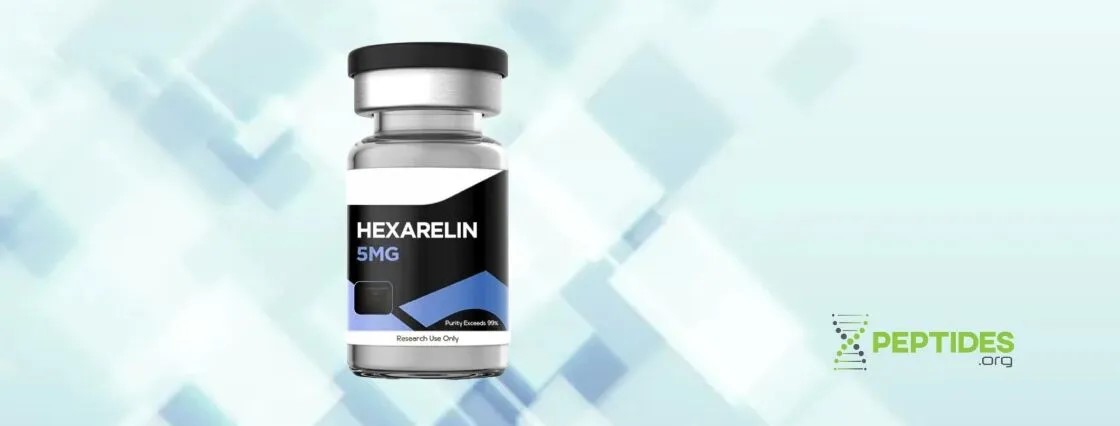An expanding number of scientific studies are being launched to examine Hexarelin peptide, a powerful growth hormone-releasing peptide. Research on Hexarelin has expanded beyond its original purpose as a GH-releasing peptide to examine its cardioprotective and neuroprotective potential. Hypothesized Hexarelin properties, like those of other growth hormone secretagogues, may include:
Possible improvements in research-based muscle growth
Possible restoration and regulation of sleep
Possible reduction of fat cell storage and lypolisis
Here, you will find information on Hexarelin research, its proposed mechanism of action, and internet sources for research-grade peptides.
Hexarelin Peptide: What is it?
Studies suggest that the synthetic six-amino-acid peptide known as Hexarelin may mimic the action of ghrelin at the pituitary and hypothalamic growth hormone secretagogue receptors (GHS-Rs). This tiny peptide’s discovery was attributed to Tulane University researchers. They suggested that Hexarelin may release growth hormone potentially more effectively than bigger, longer-established synthetic peptides and was much less likely to desensitize the pituitary response.
Regarding GH deficiency, Hexarelin has been the subject of substantial research by Europeptides and Mediolanum Farmaceutici. Research indicates that Hexarelin may be potentially relevant in other avenues of research, and smaller groups are looking into these, including its potential cardiovascular and neurological potential unrelated to GH. Investigations purport that Hexarelin may have encouraging results in several areas, including the context of amyotrophic lateral sclerosis (ALS), the improvement of insulin sensitivity in diabetic research models, and the shortening of recovery time after cardiac bypass surgery.
Qualified researchers and laboratory workers can access Hexarelin and other peptides in its class for in vitro experiments at biotechpeptides.com.
Hexarelin Peptide: Possible Functions
Hexarelin is a synthetic analog of ghrelin, but its proposed longer half-life and higher efficacy make it the preferred choice of researchers in their experiments over ghrelin. Findings imply that the pulsatile release of growth hormone may be caused by Hexarelin’s affinity for the GHS-R, which may have later impacts such as:
Increase in muscular tissue development;
Enhanced collagen production;
Increased bone density;
Accelerated recovery of soft tissues;
Enhanced responsiveness to insulin;
Anti-aging properties within the cell
Hexarelin has been speculated to have neuroprotective potential in addition to the associations researchers have made between the peptide and GH release, such as:
In the hippocampus, the peptide’s potential activation of the PI3K/Akt pathway may protect neurons against too-high intracellular calcium levels, which can harm their signaling.
It may potentially control the production of nitric oxide and the release of free radicals that might kill neurons;
It might induce a decrease in brain tissue inflammation;
It may prove valuable to mitochondrial production, decreasing oxidative stress in general.
Scientists speculate that the potential to activate the CD36 scavenger receptor may be another intriguing aspect of Hexarelin. Some of the practical metabolic outcomes that may occur when CD36 is working in research models may include:
Brown adipose tissue may develop more rapidly; it appears to play an important role in thermogenesis, glucose metabolism, and energy generation.
It may enhance lipid metabolism, particularly in white fat cells—the main culprits in metabolic diseases, including obesity.
The organism’s energy generation, DNA/RNA synthesis, muscular contractions, and many other processes may be powered by adenosine triphosphate, or ATP, which may be produced at an increased rate following peptide exposure, and,
It may potentially enhance insulin sensitivity in the liver.
Now that we have discussed Hexarelin’s possible impacts let’s examine why researchers have continued to study this peptide.
Hexarelin Peptide Potential
Researchers have suggested that Hexarelin may be relevent to several potential avenues of research by outlining its main impacts. Researchers interested in cardiac function, muscle-building, sleep regulation, and rehabilitation, are particularly drawn to Hexarelin.
Hexarelin Peptide and the Heart
According to a meta-analysis conducted by Mao et al. (2014), Hexarelin suggested more promise than traditional ghrelin supplementation in several cardiovascular outcomes, including normalizing diastolic pressure, reducing apoptosis of the cardiomyocytes, improving or reversing atherosclerosis, and restoring heart function after ischemia and myocardial infarction.
Another research indicated that rats may have been prevented from the development of atherosclerosis by lowering blood total and LDL cholesterol levels when under a high-fat diet, which is considered to promote atherosclerosis. The experimental group received Hexarelin for 30 days, while the control group received a placebo. It was hypothesized that atherosclerotic plaque development appeared reduced, cholesterol levels seemed improved, and the generation of harmful foam cells was decreased in rats presented with Hexarelin.
Researchers in another study theorized that a single Hexarelin concentration immediately after myocardial infarction might improve cardiac functioning, ejection fraction, and fractional shortening compared to placebo rats. This was due to a parasympathetic shift in autonomic nervous system activity.
Hexarelin Peptide and Fat Cells
Research is ongoing into the muscle cell-building and muscle cell-preserving potential of Hexarelin peptide and other growth hormone-releasing peptides (GHRPs). Muscle mass loss may be caused over time by certain conditions or procedures (such as chemotherapy). Research indicates that by potentially counteracting the mitochondrial damage caused by cisplatin, Hexarelin may reduce cachexia and sarcopenia in mice given certain chemotherapeutic compounds.
Additionally, Hexarelin peptide was hypothesized to improve calcium homeostasis in muscle tissue and increase muscle fiber area, contributing to improved research model strength output. Curiously, the approach appeared to have restored intracellular calcium homeostasis and enhanced caffeine sensitivity. Studies have purported that caffeine may enhance physical activity by increasing contractile strength and energy output. Hexarelin has been theorized to have the potential to reverse the effects of caffeine desensitization. Increasing physical activity may promote the secretion of more growth hormones, facilitating the organism’s innate mechanisms for constructing muscle.
Hexarelin Peptide Additional Research
The potential of Hexarelin to aid in healing after strain or injury is among its most hypothesized characteristics. A group of Danish researchers suggested in 2010 that collagen synthesis may have increased sixfold after 14 days of peptide exposure. Compared with the control group, this greatly seemed to improve skeletal muscles’ and tendons’ matrix tissue strength.
In addition to potentially reversing the age-related decrease in slow-wave sleep, Hexarelin-induced GH release has been hypothesized to promote comparable tissue repair. One study indicated that GH production may potentially positively correlate with slow-wave sleep, suggesting that GH might be impactful in regulating the ideal sleep/wake cycle.
References
[i] Torsello, A., Grilli, R., Luoni, M., Guidi, M., Ghigo, M., Wehrenberg, W., Deghenghi, R., Müller, E., Locatelli, V. (1996). Mechanism of Action of Hexarelin. I. Growth Hormone-Releasing Activity in the Rat. European Journal of Endocrinology, 135(4), 481–488. https://doi.org/10.1530/eje.0.1350481
[ii] Mao, Y., Tokudome, T., & Kishimoto, I. (2014). The Cardiovascular Action of Hexarelin. Journal Of Geriatric Cardiology: JGC, 11(3), 253–258. https://doi.org/10.11909/j.issn.1671-5411.2014.03.007
[iii] Meanti, R., Licata, M., Rizzi, L., Bresciani, E., Molteni, L., Coco, S., Locatelli, V., Omeljaniuk, R. J., & Torsello, A. (2023). Protective Effects of Hexarelin and JMV2894 in a Human Neuroblastoma Cell Line Expressing the SOD1-G93A Mutated Protein. International Journal of Molecular Sciences, 24(2), 993. https://doi.org/10.3390/ijms24020993
[iv] Mosa, R. M., Zhang, Z., Shao, R., Deng, C., Chen, J., & Chen, C. (2015). Implications of Ghrelin and Hexarelin in Diabetes and Diabetes-Associated Heart Diseases. Endocrine, 49(2), 307–323. https://doi.org/10.1007/s12020-015-0531-z.
[v] Kraemer, W. J., Ratamess, N. A., Hymer, W. C., Nindl, B. C., & Fragala, M. S. (2020). Growth Hormone(s), Testosterone, Insulin-Like Growth Factors, and Cortisol: Roles and Integration for Cellular Development and Growth With Exercise. Frontiers in Endocrinology, 11(33). https://doi.org/10.3389/fendo.2020.00033.
[vi] Rodrigue-Way, A., Demers, A., Ong, H., & Tremblay, A. (2007). A Growth Hormone-Releasing Peptide Promotes Mitochondrial Biogenesis and a Fat Burning-Like Phenotype Through Scavenger Receptor CD36 in White Adipocytes. Endocrinology, 148(3), 1009–1018. https://doi.org/10.1210/en.2006-0975
[vii] Mosa, R., Huang, L., Wu, Y., Fung, C., Mallawakankanamalage, O., LeRoith, D., & Chen, C. (2017). Hexarelin, a Growth Hormone Secretagogue, Improves Lipid Metabolic Aberrations in Nonobese Insulin-Resistant Male MKR Mice. Endocrinology, 158(10), 3174–3187. https://doi.org/10.1210/en.2017-00168.
[viii] Townsend, K., & Tseng, Y. H. (2012). Brown Adipose Tissue: Recent Insights Into Development, Metabolic Function and Therapeutic Potential. Adipocyte, 1(1), 13–24. https://doi.org/10.4161/adip.18951
The post Research and Properties of Hexarelin appeared first on The Romania Journal.





